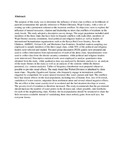| dc.description.abstract | The purpose of this study was to determine the influence of inter-clan conflicts on livelihoods of pastontl communities the specific reference to Waberi Division, Wajir County, with a view of coming up with a permanent solution to the recurrent conflicts. Its objectives were to explore the' influence of natural resources, clanism and leadership on inter-clan conflicts of residents in the study locale. The study adopted a descriptive survey design.
The target population included adult members of the three clans that have been in frequent conflicts with each other, members of Wajir District security committee, local political and religious leaders as well as leaders of international humanitarian organizations such as the Kenya Red Cross Society, Save the Children, AMREF,. Oxfam G.B. and Medicines San Frontiers. Stratified random sampling was employed to sample members of the three target clans, while 50% of the political and religious leaders were selected and studied. Focused group discussion (FGD) guides were prepared and used to collect information from representatives of each of the jhree clans.
Questionnaires were used to collect data from the district security committee. while political and religious leaders were interviewed. Descriptive statistical tools were employed to analyse quantitative data obtained from the study, while qualitative data was analysed by thematic analysis i.e. an analysis of:the main 1hemes in the study as well as an analysis of the contents within the themes presented, (i.e. content analysis). Tables of frequency distribution were prepared whenever
,
possible to provide visual effects. The study found that Waberi Division is inhabited by three
main clans - Degodia, Ogaden and Ajuran, who frequently engage in intennittent conflicts triggered by competition for scarce natural resources like water, pasture and land. The conflicts have had drastic effects on the local population, including loss of human lives. loss of livestock, vandalism of water sources, migration from settlement areas and several related negative effects. The net effect is that water scarcity level is escalated and the bad situation develops to worse; The poverty level of residents is therefore increased. The study recommends that the government should increase the number of water points in the division and, where possible, sink boreholes for each of the neighbouring clans. Further, the local population should be sensitized to share the little resources available instead of vandalising them since nobody gains from such acts, but everyone looses. | en_US |

